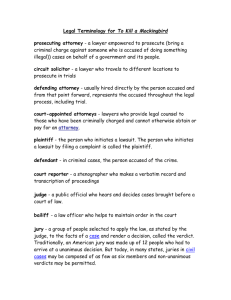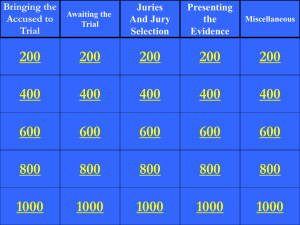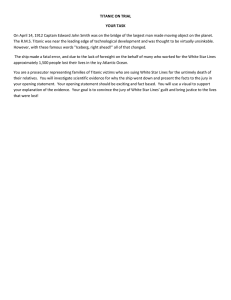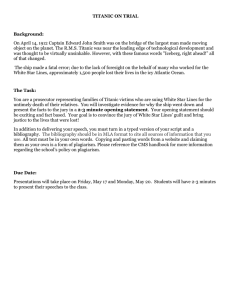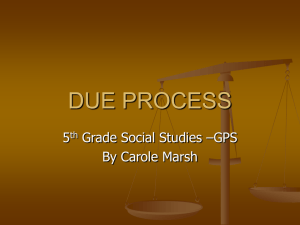THE TRIAL IN CANADIAN COURTS – Part 3
advertisement
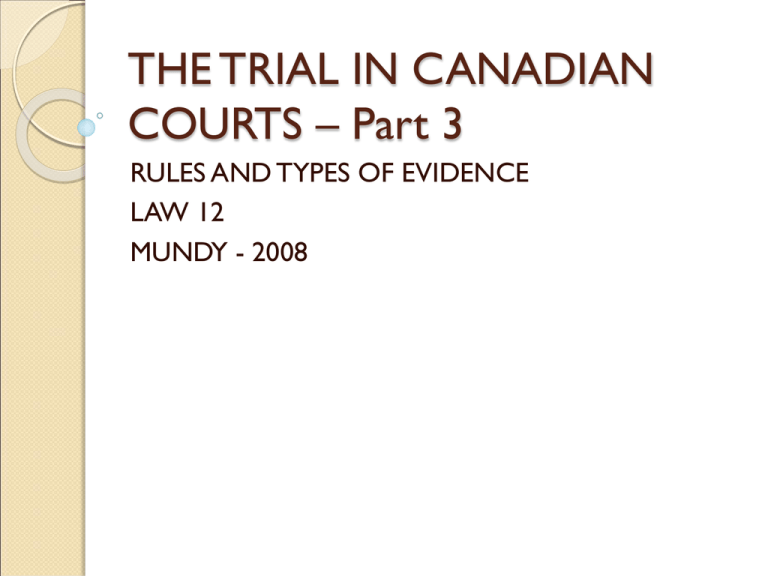
THE TRIAL IN CANADIAN COURTS – Part 3 RULES AND TYPES OF EVIDENCE LAW 12 MUNDY - 2008 RULES/TYPES OF EVIDENCE Admissibility of evidence means whether evidence should be allowed to be presented to a judge or jury to weigh an accused’s guilt or innocence If there is doubt on either side whether any evidence should be admitted, a voir dire is held During this, jury leaves and both sides make presentations to judge Judge then rules on whether it is admitted SELF-INCRIMINATION Self-incrimination is grounds under which a witness can refuse to respond to a question asked while on the stand Witness is protected from having any statements they make on stand that might “incriminate that witness in any other proceeding” Exception is perjury, in which witness gives intentionally misleading evidence PRIVILEGED COMMUNICATIONS This category of communication cannot be required to be presented in court as evidence Example – spouses are not required to give testimony against accused; they are, however, able to give as defence Other examples: parishioners & clergy, patients & doctors, etc. SIMILAR FACT EVIDENCE Evidence that shows the accused has committed similar offences in the past Purpose is to show accused has a pattern of criminal behaviour (if, for ex., accused claims it was an accident However, voir dire is held to determine if any similar fact evidence is relevant to case HEARSAY EVIDENCE Evidence not given from the personal knowledge or experience of the witness testifying Given when witness gives testimony regarding what someone else said or wrote Ex. – On stand, Mr. A testifies, “Ms. B told me that she saw Mr. C rob the grocery store.” HEARSAY EVIDENCE, cont’d. Hearsay evidence cannot be admitted as evidence Exceptions: ◦ out-of-court statement (but only to show statement was made, not admitted for its content) ◦ Witness quoting from someone dying (now dead and cannot testify) ◦ Evidence considered necessary & reliable OPINION EVIDENCE Evidence by witness regarding their thoughts, assumptions, conclusions about what they experienced Ex. – “He was staggering and couldn’t speak clearly. I think he was drunk.” Exceptions – qualified experts on a subject are allowed to give opinion, but only where topic is beyond knowledge of both judge and jury CHARACTER EVIDENCE Evidence showing accused as having either positive or negative traits Crown is restricted use of this kind of evidence; therefore it cannot use prior convictions as evidence towards case However, if defence gives character evidence, Crown allowed to refute it by introducing evidence to contrary (such as prior convictions) CHARACTER EVIDENCE As well, if accused decides to take stand and testify, Crown may cross-examine, but only to determine if any statements made were false (i.e. – cannot attack credibility of accused) PHOTOGRAPHS Can be admitted as evidence only if they are accurate depiction of crime scene Photographer or developer may take stand to answer questions on process of picture taken (to ensure photo is valid) Photos meant merely to incite jury can be considered inadmissible by judge ELECTRONIC DEVICES & VIDEO SURVEILLANCE Considering principle of “reasonable expectation of privacy”, recording conversations that are private are not admitted as evidence; UNLESS: ◦ Police have secured a court order authorizing them to do so ◦ One of the two parties involved in the conversation have consented to being recorded ELECTRONIC DEVICES & VIDEO SURVEILLANCE In emergencies in which serious harm can be prevented, police are allowed to record conversations Video surveillance is also admissible if recording public areas If video or listening devices are used to ‘spy’ on person or their property, search warrant is required first POLYGRAPH EVIDENCE Polygraph (lie detector) evidence cannot be admitted as evidence, deemed as hearsay evidence Only evidence can be what the accused said; however, polygraph operator cannot give testimony as to whether analysis showed person’s responses to be truth or lies CONFESSION Acknowledgement by accused that some or all of charges/accusations are true Can be admitted as evidence if: ◦ Given after accused was arrested and given rights to legal counsel ◦ Confession was voluntary (i.e.- not made while tortured, lengthy questioning, or given leniency if confessed) CONFESSION 2 types: Inculpatory confession – admission of guilt Exculpatory confession – denial of guilt ILLEGALLY OBTAINED EVIDENCE Typically not admitted as evidence However, can be admitted if judge rules that evidence does not bring “the administration of justice into disrepute”
